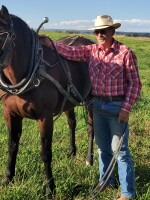Observers of trade negotiations between the U.S. and China agree that, although their trade war isn't over, the truce could last a while. Both China’s Xi and Trump seem to want a somewhat calmer relationship. But the trade situation is volatile, with both countries scrambling to reduce their dependence on each other, while there is a possibility that hostilities could resume at any moment, and soybean farmers could be caught in the middle again. Yesterday, Soybeans hit a 16 month high, but traders point out that Brazil still has an edge on U.S. soybeans because they have lower input costs, and China may be encouraged to abandon the deal and shift purchases to Brazil in the future.
Although American Soybean Association President and Kentucky farmer Caleb Ragland, pointed out in an interview with DTN, that the purchases aren't enough to make soybean growing profitable for most U.S farmers, and if the truce ends, he thinks that China’s purchases will most likely end as well. Farmers are also concerned that although Chinese purchases will help soybean growers in the short run, they might become overdependent on China, rather than developing alternative markets. Also, U.S. farmers still face high input costs that are also tied to tariffs on Chinese imports.
The U.S. crackdown on illegal immigrants over the past five months or so, has had serious consequences for many farms and dairies, which is no surprise, because earlier this year, the Senate and House’s research and analysis group, Congressional Research Service, “estimated that 680,000 farmworkers are illegal immigrants that makes up 35% of the U.S. agricultural workforce.” The U.S. Department of Labor recently reported that the ouster of illegal aliens from the U.S. “is threatening the stability of domestic food production and prices for U.S. consumers.” This group of farm and ranch workers is a larger percentage than U.S. citizens at 27%, foreign guest workers, 16% or the 22% of non-citizens with authorization to work in the U.S, such as H-2A Temporary Agricultural workers. However, in July, Secretary of Agriculture Brooke Rollins cheerfully predicted that the Trump immigration policy would soon remake the U.S. farm workforce into “100 percent American.”
A year ago or so, I reported on virtual fencing, which uses GPS positioning to delineate virtual fences, either in pastures, farm fields, or public lands. Receivers on halters that are around the neck of each cow, bull or steer in a herd, gives animals a gentle shock when they begin to move close to a GPS fence, and a stronger shock if they continue to move toward the fence. This technology is turning out to be a somewhat revolutionary technology for cattlemen. I recently talked to a public lands rancher who grazes his cattle on a high elevation Forest Service permit. Fence maintenance has been difficult because of the high elevations, steep terrain and patches of thick forests where fallen trees often damage fences, requiring considerable labor to maintain them to keep cattle from drifting out of the permit boundaries. After two years of use of the virtual fencing, he is sold on the technology because it has reduced the time he used to spend repairing fences, and finding the cattle that are spread out on the 10 square mile permit. This fall, the time it took him to gather cows and calves was cut by a couple of days. Ranchers are also realizing that virtual fencing facilitates moving their cattle quickly when wildfire and other natural disasters strike.
Author George Orwell wrote, "In a time of universal deceit, telling the truth is a revolutionary act.






